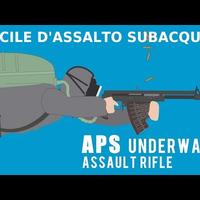Le ARMI più STRANE della STORIA: il fucile degli UOMINI RANA sovietici
the|weapons|more|strange|of the|history|the|rifle|of the|men|frog|Soviet
||||||||||RANA|soviéticos
DIE GRÖSSTEN WAFFEN DER GESCHICHTE: das Gewehr der sowjetischen FROG MEN
LAS ARMAS MÁS EXTRAÑAS DE LA HISTORIA: el fusil de los hombres rana soviéticos
Les armes les plus étranges de l'histoire : le fusil des hommes-grenouilles soviétiques
歴史上最も奇妙な武器:ソ連のフロッグメンのライフル銃
De vreemdste wapens uit de geschiedenis: het geweer van de Sovjet-ROVJETJES
najdziwniejsza broń w historii: karabin radzieckich żabojadów
AS ARMAS MAIS ESTRANHAS DA HISTÓRIA: a espingarda dos FROG MEN soviéticos
HISTORIENS MÄRKLIGASTE VAPEN: geväret från de sovjetiska grodmännen
The STRANGEST WEAPONS in HISTORY: the rifle of the Soviet FROGMEN
Il fucile d'assalto subacqueo APS.
the|rifle|assault|underwater|APS
The underwater assault rifle APS.
Il fucile APS è stato sviluppato da Vladimir Simonov,
the|rifle|APS|it is|has been|developed|by|Vladimir|Simonov
The APS rifle was developed by Vladimir Simonov,
assieme alla pistola SPP-1, nel corso degli anni '70 in Unione Sovietica, in modo tale
together|to the|gun|SPP-1|in the|course|of the|years|in|Union|Soviet||way|such
|||||curso||||||||
along with the SPP-1 pistol, during the 1970s in the Soviet Union, so that
che i sommozzatori, detti "uomini rana", potessero sparare sott'acqua.
that|the|divers|called|men|frog|they could|to shoot|underwater
||buceadores||||||
||mergulhadores||||||debaixo d'água
divers, known as "frogmen", could shoot underwater.
In precedenza, l'unico metodo che aveva un sommozzatore per contrattaccare il nemico,
In|previous|the only|method|that|he had|a|diver|to|to counterattack|the|enemy
|||||||mergulhador||||
Previously, the only method that a diver had to counterattack the enemy,
era un coltello, o un fucile AK-47 tenuto in una custodia impermeabile che però poteva
it was|a|knife|or|a|rifle|AK-47|held|in|a|case|waterproof|that|but|could
|||||||mantido|||||||
was a knife, or an AK-47 rifle kept in a waterproof case that could only
essere utilizzato solo in superficie.
to be|used|only|in|surface
be used on the surface.
Il design dell'arma era semplice e grezzo, ma ha una portata più efficace di una pistola
the|design|of the weapon|it was|simple|and|rough|but|it has|a|range|more|effective|than|a|pistol
||||||rústico|||||||||
The design of the weapon was simple and crude, but it has a more effective range than a
subacquea.
underwater
submarine pistol.
L'APS aveva montata una canna liscia, una struttura in acciaio estruso, un mirino, e
the APS|it had|mounted|a|barrel|smooth||structure|made of|steel|extruded||sight|and
|||||liscia|||||extrudido|||
||||cano|lisa|||||extrudido||mira telescópica|
The APS was equipped with a smooth barrel, an extruded steel structure, a sight, and
sparava sfruttando un meccanismo chiamato sottrazione di gas.
he was shooting|exploiting|a|mechanism|called|subtraction|of|gas
shooting|explorando||||subtração de gás||
fired using a mechanism called gas operation.
Il caricatore con una capacità di 26 colpi, aveva una forma poco bella esteticamente per
the|magazine|with|a|capacity|of|shots|it had|a|shape|not very|beautiful|aesthetically|for
|cargador||||||||||||
|carregador||||||||||||
The magazine, with a capacity of 26 rounds, had an aesthetically unpleasing shape due to
via delle sue munizioni lunghe e ristrette.
way|of the|her|ammunition|long|and|restricted
||||||estrechas
||||||reduced
its long and narrow ammunition.
Queste erano dei proiettili a forma di ago lunghi 120 mm, inseriti in un caricatore standard.
these|they were|some|bullets|with|shape|of|needle|long|mm|inserted|in|a|magazine|standard
|||||||aguja|||||||
|||projéteis||||há|||||||
These were needle-shaped projectiles 120 mm long, inserted into a standard magazine.
L'effettiva velocità del fuoco, la precisione e il raggio d'azione dipendevano dalla profondità
the actual|speed|of the|fire|the|accuracy|and|the|range|of action|depended|on the|depth
||||||||raio||||
The actual rate of fire, accuracy, and range depended on the depth
d'immersione in cui venivano esplosi i colpi.
of immersion|in|in which|they were|exploded|the|shots
of immersion at which the shots were fired.
Per esempio, a una profondità di 5 metri, l'APS avrebbe un raggio d'azione effettivo
for|example|at|a|depth|of|meters||would have|a|radius|of action|effective
For example, at a depth of 5 meters, the APS would have an effective range
di 30 metri.
of|meters
of 30 meters.
Se il sommozzatore andasse a 40 metri di profondità, la portata del fucile diminuirebbe fino a
if|the|diver|he went|at|meters|of|depth|the|range|of the|gun|would decrease|a|to
If the diver went to a depth of 40 meters, the range of the rifle would decrease to
11 metri.
meters
11 meters.
Era possibile sparare in superficie con l'arma, ma consentito solo in casi di emergenza estrema,
it was|possible|to shoot|on|surface|||but|allowed|only|in|cases|of|emergency|extreme
It was possible to shoot on the surface with the weapon, but only allowed in cases of extreme emergency,
poiché il ciclo di vita dell'arma si danneggiava gravemente se adoperata fuori dall'acqua.
since|the|circle|of|life|of the weapon|it|damaged|severely|if|used|out|of the water
|||||||danificava|||usada||
as the weapon's life cycle was severely damaged if used out of the water.
Nel 1975 il fucile APS fu adottato dall'Unione Sovietica e continuò a essere utilizzato
In|the|rifle|APS|was|adopted||Soviet|and|continued|to|to be|used
In 1975, the APS rifle was adopted by the Soviet Union and continued to be used
in Russia.
in|Russia
in Russia.
Da allora, tuttavia,
from|then|however
Since then, however,
si è cercata un'alternativa al fucile.
one|it is|searched for||to the|rifle
||procurada|||
an alternative to the rifle has been sought.
SENT_CWT:ANo5RJzT=4.8 PAR_TRANS:gpt-4o-mini=1.86
en:ANo5RJzT
openai.2025-01-22
ai_request(all=33 err=0.00%) translation(all=27 err=0.00%) cwt(all=259 err=3.09%)

